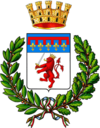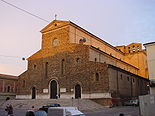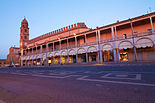Faenza
| Faenza | ||
|---|---|---|

|
|
|
| Country | Italy | |
| region | Emilia-Romagna | |
| province | Ravenna (RA) | |
| Local name | Fënza | |
| Coordinates | 44 ° 17 ' N , 11 ° 53' E | |
| height | 34 m slm | |
| surface | 215 km² | |
| Residents | 58,953 (Dec. 31, 2019) | |
| Population density | 274 inhabitants / km² | |
| Post Code | 48018 | |
| prefix | 0546 | |
| ISTAT number | 039010 | |
| Popular name | Faentini | |
| Patron saint | principale: Madonna delle Grazie ; secondari: San Pier Damiano , Sant'Umiltà |
|
| Website | Faenza | |

|
||
Faenza is a town with 58,953 inhabitants (as of December 31, 2019) in the province of Ravenna in the northern Italian region of Emilia-Romagna .
Location and dates
The town, located in the center of the region between Imola and Forlì on the Lamone , is characterized by agriculture ( viticulture and fruit growing ). In Roman times the city was called Faventia .
history
Faenza is a city of Roman origin that was already known in the Renaissance for the artful production of pottery (" faience "), which was exported to all of Europe. According to mythology, the name of the first settlement was "Faoentia" (Etruscan and Celtic roots), which means in Latin "Splendeo inter deos" or in German: "I shine among the gods". The name Faventia used by the Romans has already become a synonym for ceramic (majolica) in various languages, including French (faïence) and English (faience).
Here Quintus Caecilius Metellus Pius defeated the Popularen army of Gnaeus Carbo Papirius in 82 BC. Chr.
From the second half of the first century AD, the city flourished in the course of its agricultural production and its development and manufacture of ceramics, bricks and textiles made of linen.
Here Totila defeated the troops of the Byzantine Empire of Justinian I with an Ostrogothic army in the Battle of Faventia in 542 AD.
After a period of decadence, beginning in the second century AD and ending in the early Middle Ages, the city regained prosperity from the 8th century. After being dominated by bishops in the early Middle Ages, it became a free parish and a long period of prosperity and building activity began for the town, which culminated under the rule of the Manfredi family. The first consuls were elected in 1141 and from 1155 a Podestà (administrator, mayor) led the government of the city. In the wars between the Ghibellines and Guelphs , which began in the following years, Faenza was initially loyal to the emperor, this was also confirmed by the visit of Friedrich Barbarossa , who held court here for some time. The chronicles report that a quintana (equestrian games) was held in January 1164 in honor of Barbarossa.
In 1178, however, Faenza changed sides and joined the Lombard League . Maghinardo Pagano, who remained mayor and Capitano del Popolo for several years, was able to take over power through internal disputes.
The Manfredi were a noble family of Germanic origin who ruled the city of Faenza from 1313 to 1501. With Alberico di Guido Manfredi († 1145), the Manfredi had provided one of the leading representatives of the Guelphs loyal to the Pope in the 12th century and remained true to this tradition. Francesco I. Manfredi managed to come to power in 1313 by popular election with the title "Capitano del Popolo" with democratic means. However, the dependence on the fluctuating benevolence of the population did not seem to him to be a stable basis for permanent rule, which is why he - without any papal or imperial authorization - in 1319 as "Signore Sovrano" (ie, the immediate, subordinate lord only to the Pope, none Choice more required) in Faenza and Imola. Francesco I. Manfredi established his family's rule over the city of Faenza, which would last until 1503 with interruptions. Francesco I. Manfredi was followed by 10 members of his family who initially ruled as presumptuous lords of Faenza, but later legally as papal vicars, albeit with occasional interruptions. The height of its splendor was reached in the second half of the 14th century under Carlo II Manfredi when the city center was renewed. In 1488 Galeotto Manfredi was murdered by his wife. He was followed by his son Astorre III, who was soon killed in Rome as a prisoner by Cesare Borgia , who had occupied Faenza in 1501. His father, Pope Alexander VI. (Rodrigo Borgia) (1492–1503), in 1499 had declared all the rulers of Romagna forfeited their rights and appointed his son lord of these areas.
After the sinking of the Borgia , Faenza was robbed for a short time from the end of 1503 to 1509 by the advancing Republic of Venice , which fended off the Manfredi's attempt to return and occupied the city. Defeated in the war of the League of Cambrai, the Venetians had to restitute Faenza to the church. In the period that followed, until 1797, the city was under the direct rule of the church. The current city had a long historical development and was formed over the years by architectural influences of the Renaissance and Classicism. As early as the Renaissance , Faenza was known for the ceramics ( faience ) that are still produced today, but here they are called Maiolica (derived from Mallorca ).
Attractions
Faenza offers numerous sights such as the Palazzo del Podestà and the medieval town hall, some of which are brick buildings . Large parts of the town center were extensively restored in the years before 2006. The central square in the center of the village is flanked by two arcades, one of which is adjacent to the single bell tower ( campanile ) with its freely hanging bell. The Duomo di San Pietro Apostolo , also made of brick, does not have a bell tower, but only a small bell on the back. In the cathedral is the grave of the Doctor of the Church Petrus Damiani , who died in Faenza in 1072.
economy
There is an industrial park in Faenza, which is home to vehicle companies, mechanical workshops and electronics companies. To the northeast of the historic city center is a larger marshalling yard with an attached repair shop. Faenza is home to the Formula 1 teams Scuderia AlphaTauri that in the Formula 1 season in 2005 / 2006 from the resident also in Faenza team Minardi has emerged.
Handicrafts
The historical production of majolica is recognized worldwide as one of the greatest moments of artistic creation through ceramics. A few favorable conditions were responsible for the success: an area rich in clay and a centuries-old history of political and economic relations with Tuscany (particularly Florence ) allowed the arts and production to prosper, as can be seen in the history of the Bergantini family .
As evidence of the popularity of Faenza majolica over the centuries, Québec's Prime Minister Jean Charest announced on August 18, 2006 that Canadian archaeologists had discovered the exact location of the first French colony, Charlesbourg-Royal , by means of a found fragment of a decorative one Plate made in Faenza between 1540 and 1550. It could therefore only have belonged to a member of the French aristocracy in the colony.
Faenza is home to an International Ceramic Museum. The museum displays pieces from around the world and from all eras, from classic amphorae to the works of Chagall and Picasso, and there is a rich section devoted to Faenza pottery in the golden age of the Renaissance. Other interesting art collections can be seen in the Municipal Art Gallery, the Diocesan Museum and the Bendandi Manfredi Library.
Typical faience works from Faenza:
Events
- Palio del Niballo: Equestrian games, the roots of which go back to 1414. Their purpose was to fight Hannibal (Niballo is a corruption of Hannibal) who once besieged the city. Niballo is now the target. The games take place on the fourth Sunday in June each year. The colorful competition in historical costumes lasts at least two hours and is therefore much longer than the famous Palio di Siena . Riders from the five districts (Rioni) fight to see who is the first to hit the two eight-centimeter targets in the hands of a Hannibal doll. The event takes place in the municipal stadium "Bruno Neri" and starts at 6 pm.
- Nott de Bisò: Mulled wine night , always on January 5th, when people gather in the central square from 7 p.m. and then throw a doll, dressed in the colors of the victorious district on the Palio from the previous year, into the fire.
- 100 km del Passatore: Ultramarathon that runs over 100 km from Florence to Faenza on the last Saturday in May. The difficulty lies not only in the distance, but also in the enormous height differences that have to be overcome in the Apennines .
Twin cities
Faenza has the following nine city partnerships
| city | country | since |
|---|---|---|
| Bergerac |
|
1998 |
| Gmunden |
|
2008 |
| Jingdezhen |
|
2013 |
| Marousi |
|
1992 |
| Rijeka |
|
1983 |
| Schwäbisch Gmünd |
|
2001 |
| Talavera de la Reina |
|
1986 |
| Timișoara |
|
1991 |
| Toki |
|
1979 |
Personalities
- Domenico Paganelli (1545–1624), architect
- Evangelista Torricelli (1608-1647), physicist
- Giovanni Carlo Boschi (1715–1788), cardinal
- Antonio Tamburini (1800–1876), opera singer
- Giuseppe Gallignani (1851–1923), composer and music teacher
- Bruno Bandini (1889–1969), violist, conductor and music teacher
- Ercole Gallegati (1911-1990), wrestler
- Giacomo Neri (1916-2010), football player and coach
- Vito Ortelli (1921–2017), racing cyclist
- Antonio Paolo Albonetti (* 1942), racing cyclist
- Aurelio Samorì (* 1946), composer
- Fabiano Fontanelli (* 1965), racing cyclist
- Raffaella Reggi (* 1965), tennis player
- Fabio Babini (* 1969), racing car driver
- Massimo Rivola (* 1971), motorsport official
- Laura Pausini (* 1974), singer
- Eddy Serri (* 1974), road cyclist
- Riccardo Chiarini (* 1984), road cyclist
- Filippo Savini (* 1985), racing cyclist
- Alberto Contoli (* 1987), road cyclist
Web links
Individual evidence
- ↑ Statistiche demografiche ISTAT. Monthly population statistics of the Istituto Nazionale di Statistica , as of December 31 of 2019.
- ↑ http: www.sardimpex.com/files/MANFREDI.htm
- ↑ "Faenza nell'età dei Manfredi," di Augusto Vasina, Faenza, Faenza Editrice presentazione, 1990. 18 S.
- ↑ canada.com Discovery of the first French colony ( Memento of the original from January 30, 2009 in the Internet Archive ) Info: The archive link was automatically inserted and has not yet been checked. Please check the original and archive link according to the instructions and then remove this notice.
- ↑ Official site of the Palios (Italian) with pictures and videos ( Memento of the original from April 15, 2012 in the Internet Archive ) Info: The archive link was inserted automatically and has not yet been checked. Please check the original and archive link according to the instructions and then remove this notice.
- ↑ Official website of the ultramarathon (ital.)
- ^ Faenza website
- ^ Città gemellate / Rapporti internazionali / Città / Home - Sito Ufficiale del Comune di Faenza. Retrieved January 18, 2017 .












